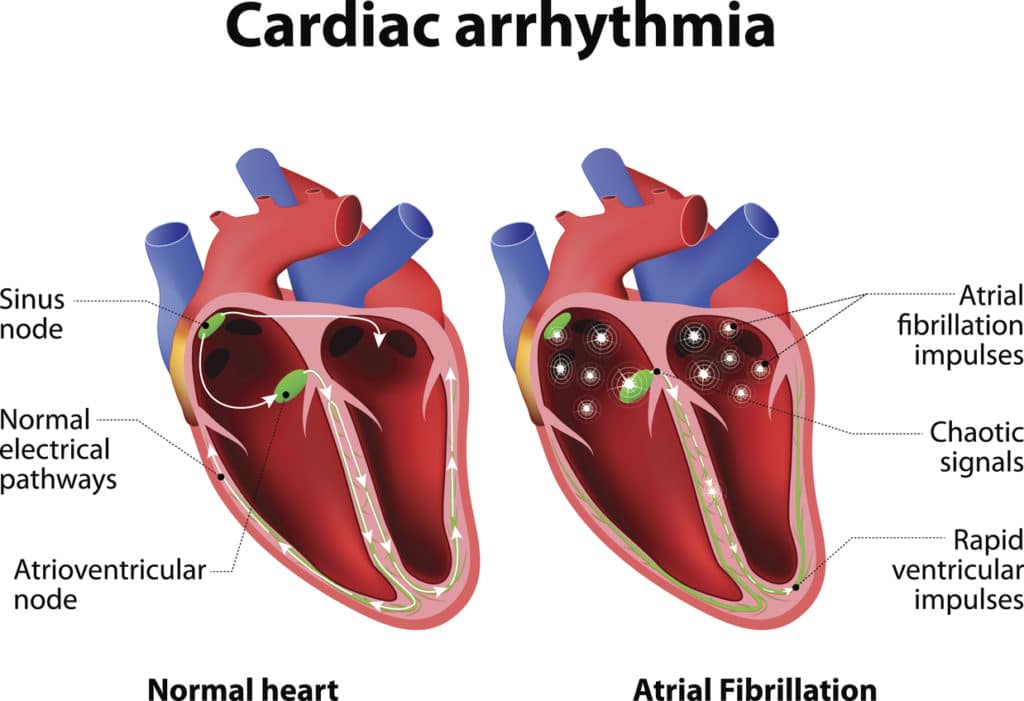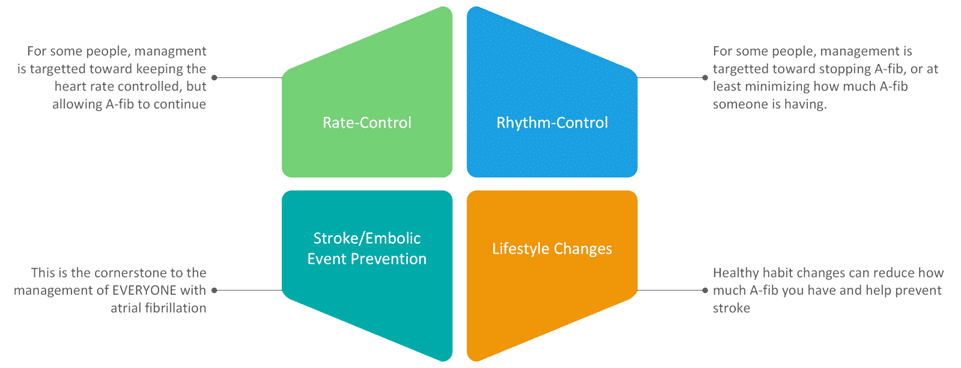AFib is an unorganized, chaotic rhythm that originates from the pulmonary veins in the left atrium (the heart’s top left chamber). The cells in the pulmonary veins ordinarily do not have any electrical activity. Still, those with atrial fibrillation gain electrical activity and start firing in a rapid, irregular pattern. A-fib is an irregularly irregular rhythm in which the heart beats without a regular pattern.

Why Do People Get Atrial Fibrillation?
Sometimes it is unknown why people get A-fib. Sometimes A-fib is caused by damage to the heart’s electrical system from conditions including:
- High blood pressure
- Coronary artery disease (cholesterol blockages in the arteries supplying the heart)
- Heart failure
- Heart surgery
- Sleep apnea (Disordered breathing while sleeping)
- Thyroid disease (hormonal imbalance)
- Lung disease
- Structural heart disease (leaky or tight heart valves, other heart conditions from birth)
- Drinking too much alcohol or using drugs
- Serious illness or infection
- Advanced age
- Smoking
- Diabetes
- Obesity (being overweight)
- Exercising very hard and very often
AFib is a progressive disease. Unless there is an underlying cause that can be corrected, it always gets worse over time. It initially starts as paroxysmal atrial fibrillation when it comes and goes. Over time, the episodes start increasing in length and severity. Patients start having more and more events to the point that they are now in it all the time. That’s when it progresses and is called persistent atrial fibrillation. Inside the heart, that usually means it has spread beyond the pulmonary veins. The success of the treatment is lower the longer a patient has A-fib and the more it progresses.
Is it Dangerous?
A-fib can feel very scary, but it is not deadly. If A-fib is not treated properly, it can cause health complications including:
- Embolic Events: blood clots can form in the heart and injure the brain (stroke) or other body parts
- Heart Failure: condition in which the heart’s pumping ability is weakened
Signs & Symptoms of Atrial Fibrillation
Some people do not have any symptoms when they are in a-fib. Other people have bothersome symptoms. Signs and symptoms of A-fib include:
- Fatigue
- Tiring more easily or getting more short of breath than usual with exercise or ordinary activity
- Fast or irregular pulse
- Palpitations (feelings of having a fast-beating, fluttering, or pounding heart)
- Shortness of breath
- Chest pain, pressure, tightness, or discomfort
- Dizziness or lightheadedness
- Mental fogginess
- Fluid retention/acute congestive heart failure (leg swelling, weight gain, difficulty breathing, particularly with activity or lying flat, abdominal distension)
- Fainting (unusual)
- Increased urination
What should I do for an A-fib Episode?
If the episode feels like past ones and you feel okay, you can do your usual activities. Listen to your body: rest if you need to. You can try relaxation exercises, such as mindfulness meditation or deep breathing. Please remember how long your symptoms last, how you felt during the episode(s), any identifiable triggers or relievers, and whether you are experiencing a change in episode frequency or duration. Your provider will want to discuss these things on your next visit.
Heart rhythm symptoms to call your provider about:
- Heart rate greater than 120 beats per minute at rest, lasting more than 1 hour
- Weight gain of 3 lbs overnight, or 5 lbs in 1 week
- Dizziness
- Lightheaded
- Changes in your shortness of breath that worry you
- Mild discomfort in your chest
- Symptoms feel worse than usual, or you start feeling worse
- Bothersome A-fib episode that has lasted longer than 24 hours
Heart rhythm symptoms to go to the ER for:
- Moderate-to-severe chest pain
- Fainting or feeling like you might faint
- New-onset shortness of breath or difficulty breathing at rest
- Signs of Stroke (sudden weakness, numbness, visual changes, facial drooping, difficulty speaking, trouble walking, change in level of alertness, extremely severe headache)
How is it Diagnosed?
- ECG (also called EKG): a non-invasive test that records the heart’s electrical activity for 10 seconds.
- Ambulatory Rhythm Monitoring
- Wearable Devices:(Link from Heart Rhythm Society)“Be Smart with Your Heart: Smart Devices and AFib”
- Pacemaker or Defibrillator check: sometimes people have these implanted devices for other health problems and A-fib happens to be found on a device check
Afib Treatment
Treatment for AFib is divided into Four quadrants of AFib Care
1)Rate Control
- Commonly Used Medications: metoprolol, carvedilol, atenolol, propranolol, diltiazem, verapamil, Digoxin
- Atrioventricular (AV) Node Ablation
2)Rhythm Control
- Commonly used medications: flecainide, propafenone, amiodarone, dronedarone, Betapace (sotalol), Tikosyn (dofetilide)
- Cardioversion
- Atrial Fibrillation Ablation
- Other Surgical approaches
3)Stroke/Embolic Event Prevention
- Medications:
- Vitamin K antagonists: Coumadin (Warfarin)
- Direct-Acting Oral Anticoagulants (DOACS): Eliquis (apixaban), Xarelto, (rivaroxaban), Pradaxa (dabigatran), Savaysa (edoxaban)
- Left Atrial Appendage Occlusion
4) Risk Factor Management: exercise, weight loss, moderating/quitting alcohol, quitting drugs, treating sleep apnea, and controlling chronic diseases such as hypertension, coronary disease, diabetes, heart failure, thyroid disease, and lung disease can greatly impact how much A-fib you have.
- Attain/maintain healthy body weight: SDCA has many tools to help you lose weight, including nutritional counseling , weight loss clinic , tips and recipes , and classes
- Aerobic Exercise: Talk to your provider before starting an exercise program. Aim for at least 150 minutes of aerobic exercise per week. SDCA has many tools to help you reach your exercise goals including exercise physiologists on staff who can help you develop a customized exercise program, exercise classes , and Walk With a Doc
- Stop smoking: Colorado Quitline Website:
- Limit caffeine intake: some people find that caffeine can trigger A-fib, especially if they drink too much.
- Limit or stop drinking alcohol: alcohol can trigger A-fib and can make it worse. Avoiding alcohol altogether is best, but if you choose to drink, limit your alcohol intake to less than 2 drinks/day for men or less than 1 drink/day for women. Changing your relationship with alcohol can be incredibly challenging, and often support is needed. Talk with your primary care provider about your alcohol intake and habit change goals. There are also many online and in-person resources including, but not limited to, Alcoholics Anonymous.
South Denver Cardiology is a leader in the treatment of Afib and we may be able to help you or a loved one who has A-fib. If you would like to schedule an appointment with any of our Afib specialists click here, or feel free to call us at 303-744-1065



